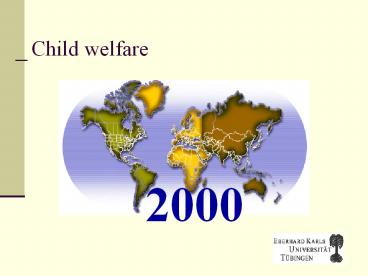Child welfare PowerPoint PPT Presentation
1 / 38
Title: Child welfare
1
Child welfare
2000
2
Measure of child welfare
- Child enrollment in school
- Primary
- Secondary
- Child health
- Mortality
- Morbidity
- Child nutrition
- Child labor
3
Child labor
4
Child Immunization
5
Immunization
6
Primary schooling
7
Female children, primary schooling
8
Secondary schooling
9
Female children, secondary schooling
10
Educating Women Reduces National Infant Mortality
Infant mortality (deaths per 1,000 births)
Sub-Saharan Africa
South Asia
Middle East North Africa
Latin America Caribbean
East Asia
OECD
70
90
110
50
Secondary education (females per 100 males)
11
Educated Women Have Healthier Children
Under 5 mortality per 1,000
Years of education of mother (Average of
household survey results)
12
Declining sex-ratio
- There are at least 60 to 100 million missing
women. - Female infanticide and sex-selective foeticide
- Declining child sex-ratios
- Relation of declining sex-ratios to the
population policies and son preference - Example
13
Percentage of female population
14
Where is there anti-girl discrimination and a
resulting shortage of girls?
- East Asia China, Taiwan, South Korea (not Japan)
- South Asia India, Nepal, Pakistan
- Not in most Muslim countries of Arab Middle
East, North Africa, Southeast Asia, or Central
Asia - Not in most of Latin America, Africa, Middle
East, Less Developed, or Least Developed
Countries - Not in Europe, North America, Russia
- Only certain cultures have such strong
traditional anti-daughter bias that is now
exacerbated by declining and low fertility,
leading to sex-selective abortion and/or excess
mortality of daughters
15
Chinas abnormal sex ratios
- Situation deteriorated 1978 to the present
- 1978-83 Announcement and implementation of
one-child policy, increased coercion in family
planning, resurgence of female infanticide - 1983-present Sharp rise in sex-selective
abortion, increasing excess female infant
mortality reported - Reported sex ratio at birth and sex ratio of
children at ages 0-4 rose to 120 boys per 100
girls in 2000 - Two positive trends Ratio of male to female
mortality rates became more normal at ages 2 and
above. Sex ratio ages 0-4 stabilized at 120
during 1997-2000
16
What causes the shortage of girls in China?
- Poverty? No, some of Chinas poorest areas have
no missing girl problem. But economic
considerations matter - Political or economic system? (No)
- Illiteracy, low educational level? (No)
- Chinese culture? YES
- Low fertility? YES. Combined with son preference.
- One-child policy? Maybe. Seems to worsen excess
female infant mortality. Perhaps shortage of
girls is more severe than without the one-child
policy
17
Declining sex-ratio in India
- National decline from 945 to 927 in the number of
girls per 1,000 boys aged 0-6 between 1991 and
2001 - Punjab, Haryana, Himachal Pradesh and Gujarat,
(fewer than 800 girls for every 1,000 boys) - The ratio is also said to be low in certain
districts, including the South West District of
Delhi, which are "amongst the most prosperous in
the country."
18
In Asia, does economic and social development
reduce anti-daughter discrimination?
- Unfortunately not. Not automatically. There is no
clear relationship - As shown by Croll, in East and South Asia, the
phenomenon of missing girls has worsened as
economies have developed, as the status of women
has improved, and as female educational
attainment has risen - In India, as in China, daughter discrimination is
found in urban areas as well as rural, and among
educated as well as uneducated mothers - The missing girl situation is also extreme in
developed East Asian societies, such as South
Korea and Taiwan
19
Life expectancy at birth female-male
20
Childhood Obesity Trends and Potential Causes
(Child Obesity)
21
Global Database on Child Growth
- 3 year project by WHO German gov. nutritional
surveillance database (HAZ, WHZ, WAZ) - Objective characterize nutritional status,
secular trends, ... worldwide! - Sources published articles, gov. stats, survey
reports (UN, NGO), gt840 surveys - Group pre-school children (here 0-4.9982)
- Surveys standardized and quality controlled
22
WHERE?
- Characterization of the health status of the
world at the end of the millennium
cross-sectional evidence (N93-118
T1995-2002) - 3 datasets constructed from the database
- Overall malnutrition HAZ, WHZ, WAZ
- Where do we find malnutrition? (by region, by
income)
23
Our Research Aim II Inductive stat. Part/WHY?
- Statistical determinants of child health at the
end of the millennium - WHO datasets combined with
- World Bank data (macroeconomic, demographic,
health, education data) - Other sources (political freedom, nutritional
input)
24
Stunting by Region
25
Stunting and Wasting by Region
26
Stunting by Development
27
Gender-stratified Malnutrition absolute
28
Gender-stratified Malnutrition relative
Ratio ( malnourished males / malnourished
females) x 100
29
Area-stratified Malnutrition
30
Area-stratified Malnutrition relative
Ratio ( malnourished rural / malnourished
urban) x 100
31
Conclusion Descriptive Part
- Overall malnutrition
- Levels Stunting 25, Underweight 19, Wasting 7
- Africa (E. and C.), Asia (S-E and S-C) extremely
retarded in growth - Gender stratified malnutrition
- More boys (n85) than girls (n25) stunted
- Divided western-eastern hemisphere
- Area stratified malnutrition
- More rural (n90) than urban (n3) stunted
- Western Africa (and Oceania) less affected
32
Regression general
33
Regression rural and urban divide
34
Regression male-female divide
35
Freedom and rural-urban divide
36
Freedom and male-female divide
37
Regarding presentation
- Presentation it must be on the topic of your
assignment - You have 10 minutes to talk
- Power point presentation is better
- Send me your ppt files by Thursday 1700
- Questions/answer session for maximum of 10
minutes
38
- Thank You

